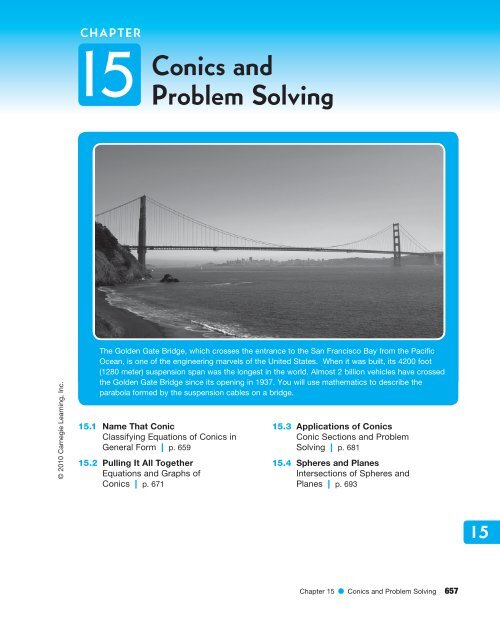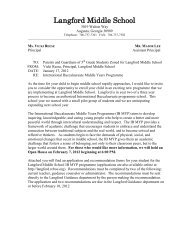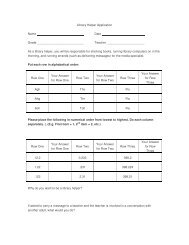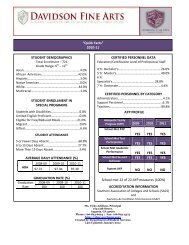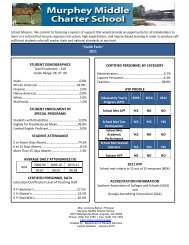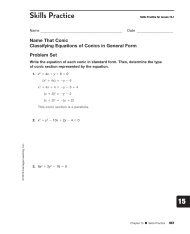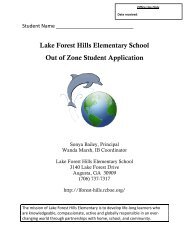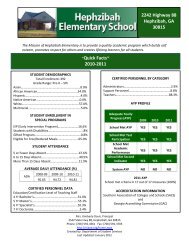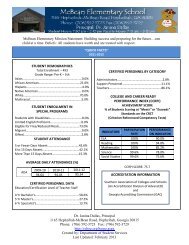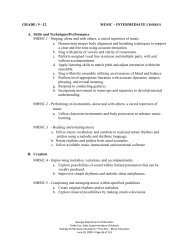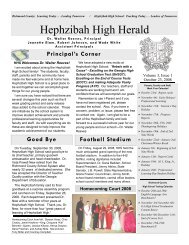Create successful ePaper yourself
Turn your PDF publications into a flip-book with our unique Google optimized e-Paper software.
CHAPTER<br />
15<br />
<strong>Conics</strong> <strong>and</strong><br />
<strong>Problem</strong> <strong>Solving</strong><br />
© 2010 Carnegie Learning, Inc.<br />
The Golden Gate Bridge, which crosses the entrance to the San Francisco Bay from the Pacific<br />
Ocean, is one of the engineering marvels of the United States. When it was built, its 4200 foot<br />
(1280 meter) suspension span was the longest in the world. Almost 2 billion vehicles have crossed<br />
the Golden Gate Bridge since its opening in 1937. You will use mathematics to describe the<br />
parabola formed by the suspension cables on a bridge.<br />
15.1 Name That Conic<br />
Classifying Equations of <strong>Conics</strong> in<br />
General Form | p. 659<br />
15.2 Pulling It All Together<br />
Equations <strong>and</strong> Graphs of<br />
<strong>Conics</strong> | p. 671<br />
15.3 Applications of <strong>Conics</strong><br />
Conic Sections <strong>and</strong> <strong>Problem</strong><br />
<strong>Solving</strong> | p. 681<br />
15.4 Spheres <strong>and</strong> Planes<br />
Intersections of Spheres <strong>and</strong><br />
Planes | p. 693<br />
15<br />
Chapter 15 l <strong>Conics</strong> <strong>and</strong> <strong>Problem</strong> <strong>Solving</strong> 657
© 2010 Carnegie Learning, Inc.<br />
15<br />
658 Chapter 15 l <strong>Conics</strong> <strong>and</strong> <strong>Problem</strong> <strong>Solving</strong>
15.1 Name That Conic<br />
Classifying Equations of <strong>Conics</strong> in<br />
General Form<br />
Objective<br />
In this lesson you will:<br />
l Classify a conic section from its equation in general form.<br />
<strong>Problem</strong> 1 General Form to St<strong>and</strong>ard Form<br />
Write the equation of each conic section in st<strong>and</strong>ard form. Then, determine the type<br />
of conic section represented by the equation.<br />
1. x 2 y 2 4x 12y 15 0<br />
© 2010 Carnegie Learning, Inc.<br />
2. 4x 2 y 2 16 0<br />
15<br />
Lesson 15.1 l Classifying Equations of <strong>Conics</strong> in General Form 659
3. 5x 2 5y 2 10x 30y 14 0<br />
4. x 2 8x y 10 0<br />
5. x 2 4y 2 6x 8y 59 0<br />
6. x 2 y 2 81 0<br />
© 2010 Carnegie Learning, Inc.<br />
15<br />
660 Chapter 15 l <strong>Conics</strong> <strong>and</strong> <strong>Problem</strong> <strong>Solving</strong>
7. 9x 2 y 2 72x 135 0<br />
8. 25x 2 9y 2 90y 0<br />
9. x 2 9y 0<br />
© 2010 Carnegie Learning, Inc.<br />
10. 100x 2 49y 2 4900 0<br />
15<br />
Lesson 15.1 l Classifying Equations of <strong>Conics</strong> in General Form 661
11. y 2 5x 0<br />
12. 25x 2 8y 2 100x 80y 100 0<br />
13. y 2 2x 6y 9 0<br />
14. x 2 y 2 20x 19 0<br />
© 2010 Carnegie Learning, Inc.<br />
15<br />
662 Chapter 15 l <strong>Conics</strong> <strong>and</strong> <strong>Problem</strong> <strong>Solving</strong>
15. 4x 2 4y 2 36<br />
16. 4x 2 16y 2 64 0<br />
<strong>Problem</strong> 2 Analyzing the General Form<br />
of Conic Sections<br />
1. List the equations in general form from <strong>Problem</strong> 1 that represent circles.<br />
a. What do you notice about the coefficients of the x 2 <strong>and</strong> y 2 terms?<br />
© 2010 Carnegie Learning, Inc.<br />
b. Why do you think this relationship occurs between the coefficients of the<br />
x 2 <strong>and</strong> y 2 terms?<br />
c. What do you notice about the coefficients of the x- <strong>and</strong> y-terms?<br />
15<br />
Lesson 15.1 l Classifying Equations of <strong>Conics</strong> in General Form 663
d. What affect do the x- <strong>and</strong> y-terms have on the circle?<br />
e. The general form of a conic section is Ax 2 By 2 Cx Dy E 0.<br />
Summarize your conclusions from parts (b) <strong>and</strong> (d) using the<br />
variables A, B, C, <strong>and</strong> D.<br />
2. List the equations in general form from <strong>Problem</strong> 1 that represent ellipses.<br />
a. What do you notice about the coefficients of the x 2 <strong>and</strong> y 2 terms?<br />
b. Why do you think this relationship occurs between the coefficients of<br />
the x 2 <strong>and</strong> y 2 terms?<br />
c. What do you notice about the coefficients of the x- <strong>and</strong> y-terms?<br />
© 2010 Carnegie Learning, Inc.<br />
15<br />
664 Chapter 15 l <strong>Conics</strong> <strong>and</strong> <strong>Problem</strong> <strong>Solving</strong>
d. What affect do the x- <strong>and</strong> y-terms have on the ellipses?<br />
e. The general form of a conic section is Ax 2 By 2 Cx Dy E 0.<br />
Summarize your conclusions from parts (b) <strong>and</strong> (d) using the<br />
variables A, B, C, <strong>and</strong> D.<br />
3. List the equations in general form from <strong>Problem</strong> 1 that<br />
represent hyperbolas.<br />
a. What do you notice about the coefficients of the x 2 <strong>and</strong> y 2 terms?<br />
b. Why do you think this relationship occurs between the coefficients of<br />
the x 2 <strong>and</strong> y 2 terms?<br />
© 2010 Carnegie Learning, Inc.<br />
c. What do you notice about the coefficients of the x- <strong>and</strong> y-terms?<br />
15<br />
Lesson 15.1 l Classifying Equations of <strong>Conics</strong> in General Form 665
d. What affect do the x- <strong>and</strong> y-terms have on the hyperbola?<br />
e. The general form of a conic section is Ax 2 By 2 Cx Dy E 0.<br />
Summarize your conclusions from parts (b) <strong>and</strong> (d) using the<br />
variables A, B, C, <strong>and</strong> D.<br />
4. List the equations in general form from <strong>Problem</strong> 1 that<br />
represent parabolas.<br />
a. What do you notice about the coefficients of the x 2 <strong>and</strong> y 2 terms?<br />
b. Why do you think this relationship occurs between the coefficients of<br />
the x 2 <strong>and</strong> y 2 terms?<br />
c. What do you notice about the coefficients of the x- <strong>and</strong> y-terms?<br />
© 2010 Carnegie Learning, Inc.<br />
15<br />
666 Chapter 15 l <strong>Conics</strong> <strong>and</strong> <strong>Problem</strong> <strong>Solving</strong>
d. What affect do the x- <strong>and</strong> y-terms have on the ellipses?<br />
e. The general form of a conic section is Ax 2 By 2 Cx Dy E 0.<br />
Summarize your conclusions from parts (b) <strong>and</strong> (d) using the variables<br />
A, B, C, <strong>and</strong> D.<br />
© 2010 Carnegie Learning, Inc.<br />
15<br />
Lesson 15.1 l Classifying Equations of <strong>Conics</strong> in General Form 667
5. Complete the following table.<br />
General Form of a Conic Section: Ax 2 By 2 Cx Dy E 0<br />
Conic Section<br />
Relationship<br />
Between A <strong>and</strong> B<br />
Inclusion of C <strong>and</strong> D<br />
Circle<br />
Ellipse<br />
Hyperbola<br />
Parabola<br />
© 2010 Carnegie Learning, Inc.<br />
15<br />
668 Chapter 15 l <strong>Conics</strong> <strong>and</strong> <strong>Problem</strong> <strong>Solving</strong>
<strong>Problem</strong> 3 Determining the Conic Section<br />
from its General Form<br />
Determine the type of conic section represented by each equation.<br />
1. x 2 6x 8y 17 0<br />
2. x 2 4y 2 4x 32y 96 0<br />
3. 7x 2 7y 2 175<br />
4. 9x 2 16y 2 36x 96y 36 0<br />
© 2010 Carnegie Learning, Inc.<br />
5. x 2 y 2 8x 4y 5 0<br />
6. 7x 2 7y 2 175<br />
Be prepared to share your methods <strong>and</strong> solutions.<br />
15<br />
Lesson 15.1 l Classifying Equations of <strong>Conics</strong> in General Form 669
© 2010 Carnegie Learning, Inc.<br />
15<br />
670 Chapter 15 l <strong>Conics</strong> <strong>and</strong> <strong>Problem</strong> <strong>Solving</strong>
15.2 Pulling It All Together<br />
Equations <strong>and</strong> Graphs of <strong>Conics</strong><br />
Objectives<br />
In this lesson you will:<br />
l Identify the type of conic section from its equation in general form.<br />
l Graph conic sections.<br />
l Identify key characteristics of conic sections.<br />
<strong>Problem</strong> 1 Key Characteristics of <strong>Conics</strong><br />
Determine the type of conic section represented by each equation. Then, write the<br />
equation in st<strong>and</strong>ard form <strong>and</strong> identify the key characteristics of the conic. Include<br />
the following key characteristics. Finally, graph <strong>and</strong> label the conic.<br />
Key<br />
Characteristics<br />
Circle Ellipse Hyperbola Parabola<br />
l center<br />
l radius<br />
l center<br />
l vertices<br />
l co-vertices<br />
l foci<br />
l eccentricity<br />
l center<br />
l vertices<br />
l co-vertices<br />
l foci<br />
l asymptotes<br />
l eccentricity<br />
l vertex<br />
l axis of symmetry<br />
l focus<br />
l directrix<br />
l concavity<br />
© 2010 Carnegie Learning, Inc.<br />
15<br />
Lesson 15.2 l Equations <strong>and</strong> Graphs of <strong>Conics</strong> 671
1. 169x 2 25y 2 350y 3000 0<br />
© 2010 Carnegie Learning, Inc.<br />
15<br />
672 Chapter 15 l <strong>Conics</strong> <strong>and</strong> <strong>Problem</strong> <strong>Solving</strong>
2. 64x 2 36y 2 72y 2340 0<br />
© 2010 Carnegie Learning, Inc.<br />
15<br />
Lesson 15.2 l Equations <strong>and</strong> Graphs of <strong>Conics</strong> 673
3. x 2 y 2 4x 2y 4 0<br />
© 2010 Carnegie Learning, Inc.<br />
15<br />
674 Chapter 15 l <strong>Conics</strong> <strong>and</strong> <strong>Problem</strong> <strong>Solving</strong>
4. y 2 12x 8y 124 0<br />
© 2010 Carnegie Learning, Inc.<br />
15<br />
Lesson 15.2 l Equations <strong>and</strong> Graphs of <strong>Conics</strong> 675
5. 64x 2 225y 2 384x 2250y 9351 0<br />
© 2010 Carnegie Learning, Inc.<br />
15<br />
676 Chapter 15 l <strong>Conics</strong> <strong>and</strong> <strong>Problem</strong> <strong>Solving</strong>
6. 4x 2 4y 2 48x 40y 144 0<br />
© 2010 Carnegie Learning, Inc.<br />
15<br />
Lesson 15.2 l Equations <strong>and</strong> Graphs of <strong>Conics</strong> 677
7. 2x 2 32x 28y 128 0<br />
© 2010 Carnegie Learning, Inc.<br />
15<br />
678 Chapter 15 l <strong>Conics</strong> <strong>and</strong> <strong>Problem</strong> <strong>Solving</strong>
8. 16x 2 25y 2 96x 300y 644 0<br />
© 2010 Carnegie Learning, Inc.<br />
Be prepared to share your methods <strong>and</strong> solutions.<br />
15<br />
Lesson 15.2 l Equations <strong>and</strong> Graphs of <strong>Conics</strong> 679
© 2010 Carnegie Learning, Inc.<br />
15<br />
680 Chapter 15 l <strong>Conics</strong> <strong>and</strong> <strong>Problem</strong> <strong>Solving</strong>
15.3 Applications of <strong>Conics</strong><br />
Conic Sections <strong>and</strong> <strong>Problem</strong> <strong>Solving</strong><br />
Objectives<br />
In this lesson you will:<br />
l Model real-world situations using equations <strong>and</strong> graphs of conic sections.<br />
l Use key characteristics, graphs, <strong>and</strong> equations of conic sections to determine<br />
locations <strong>and</strong> dimensions to solve real-world situations.<br />
<strong>Problem</strong> 1 Applying Conic Sections<br />
1. The main cables of a suspension bridge are parabolic. The parabolic shape<br />
allows the cables to bear the weight of the bridge evenly. The distance<br />
between the towers is 900 feet <strong>and</strong> the height of each tower is about 75 feet.<br />
75 ft<br />
900 ft<br />
Write an equation for the parabola representing the cable between the<br />
two towers.<br />
© 2010 Carnegie Learning, Inc.<br />
15<br />
Lesson 15.3 l Conic Sections <strong>and</strong> <strong>Problem</strong> <strong>Solving</strong> 681
2. The cross section of a satellite dish is a parabola. The satellite dish is 5 feet<br />
wide at its opening <strong>and</strong> 1 foot deep. The receiver of the satellite dish should<br />
be placed at the focus of the parabola. How far should the receiver be placed<br />
from the vertex of the satellite dish?<br />
© 2010 Carnegie Learning, Inc.<br />
15<br />
682 Chapter 15 l <strong>Conics</strong> <strong>and</strong> <strong>Problem</strong> <strong>Solving</strong>
3. Many carnivals <strong>and</strong> amusement parks have mirrors that are parabolic. When<br />
you look at your reflection in a parabolic mirror, your image appears distorted<br />
<strong>and</strong> makes you look taller or shorter depending on the shape of the mirror.<br />
The focal length of a mirror is the distance from the vertex to the focus of the<br />
mirror. Consider a mirror that is 72 inches tall with a vertex that is concave<br />
6 inches from the top <strong>and</strong> bottom edges of the mirror. What is the focal length<br />
of the mirror?<br />
6 inches<br />
© 2010 Carnegie Learning, Inc.<br />
15<br />
Lesson 15.3 l Conic Sections <strong>and</strong> <strong>Problem</strong> <strong>Solving</strong> 683
4. The orbit of the Earth follows a path that is in the shape of an ellipse with an<br />
eccentricity of ___ 1 . The length of the major axis is 186 million miles. Let the<br />
60<br />
Sun represent one focus of the ellipse. Determine the minimum <strong>and</strong> maximum<br />
distance from the Earth to the Sun.<br />
© 2010 Carnegie Learning, Inc.<br />
15<br />
684 Chapter 15 l <strong>Conics</strong> <strong>and</strong> <strong>Problem</strong> <strong>Solving</strong>
5. The orbit of the Moon follows a path that is in the shape of an ellipse with the Earth<br />
at one focus. The minimum distance from the Moon to the earth is 221,642 miles.<br />
The maximum distance from the Moon to the earth is 252,710 miles. Write an<br />
equation representing the Moon’s elliptical orbit around the earth.<br />
© 2010 Carnegie Learning, Inc.<br />
15<br />
Lesson 15.3 l Conic Sections <strong>and</strong> <strong>Problem</strong> <strong>Solving</strong> 685
6. The underpass of a bridge is in the shape of half of an ellipse <strong>and</strong> is 100 feet<br />
wide <strong>and</strong> 23 feet high. A rectangular barge is 60 feet wide <strong>and</strong> 20 feet above<br />
the water. Can the barge pass under the bridge?<br />
23 ft<br />
100 feet<br />
© 2010 Carnegie Learning, Inc.<br />
15<br />
686 Chapter 15 l <strong>Conics</strong> <strong>and</strong> <strong>Problem</strong> <strong>Solving</strong>
7. Cooling towers for nuclear power plants are hyperbolic. The shape of these<br />
towers is formed by rotating a hyperbola around a vertical axis to form a<br />
three-dimensional shape called a hyperboloid. Typically, these cooling towers<br />
are slightly larger on the bottom than the top. The design of a hyperboloid<br />
creates a draft bringing cool air into the system to aid in the cooling process.<br />
Consider the following hyperboloid. Each coordinate is measured in feet.<br />
y<br />
(–155, 123)<br />
(155, 123)<br />
Vertex (147, 0)<br />
x<br />
(–230, –442) (230, –442)<br />
a. What is the equation for the hyperbola used to generate this<br />
three-dimensional cooling tower?<br />
© 2010 Carnegie Learning, Inc.<br />
15<br />
Lesson 15.3 l Conic Sections <strong>and</strong> <strong>Problem</strong> <strong>Solving</strong> 687
. The width of the cooling tower at the base is 150 feet wider than it is at the<br />
top. How tall is the cooling tower?<br />
© 2010 Carnegie Learning, Inc.<br />
15<br />
688 Chapter 15 l <strong>Conics</strong> <strong>and</strong> <strong>Problem</strong> <strong>Solving</strong>
8. Radio signals submitted from a transmitter from a pattern of concentric<br />
circles. Use the coordinate plane to graph the broadcast range of two radio<br />
stations <strong>and</strong> the location of a radio listener’s home.<br />
a. Radio station WPOP plays top 40 hits. Plot the location of station WPOP<br />
as a point at the origin.<br />
b. Sal lives 24 miles north <strong>and</strong> 32 miles east of the radio station. His home is<br />
located on the edge of WPOP’s broadcast range. Plot the location of Sal’s<br />
home as a point on the grid. How far must a radio signal travel to reach<br />
Sal’s home?<br />
© 2010 Carnegie Learning, Inc.<br />
c. Write an equation of a circle to represent station WPOP’s maximum<br />
listening area. Graph the equation.<br />
15<br />
Lesson 15.3 l Conic Sections <strong>and</strong> <strong>Problem</strong> <strong>Solving</strong> 689
d. A new station, WREQ, just starting broadcasting. It is located 50 miles east<br />
of WPOP. Plot the location of station WREQ as a point on the grid.<br />
e. WREQ’s signal travels 30 miles. Will Sal be able to listen to WREQ from<br />
his home?<br />
f. Write an equation of a circle to represent station WREQ’s maximum<br />
listening area. Graph the equation.<br />
© 2010 Carnegie Learning, Inc.<br />
15<br />
690 Chapter 15 l <strong>Conics</strong> <strong>and</strong> <strong>Problem</strong> <strong>Solving</strong>
g. Show that a point of intersection of the two radio stations’ maximum<br />
listening areas is Sal’s home using the equations of circles representing<br />
both radio stations.<br />
© 2010 Carnegie Learning, Inc.<br />
Be prepared to share your methods <strong>and</strong> solutions.<br />
15<br />
Lesson 15.3 l Conic Sections <strong>and</strong> <strong>Problem</strong> <strong>Solving</strong> 691
© 2010 Carnegie Learning, Inc.<br />
15<br />
692 Chapter 15 l <strong>Conics</strong> <strong>and</strong> <strong>Problem</strong> <strong>Solving</strong>
15.4 Spheres <strong>and</strong> Planes<br />
Intersections of Spheres <strong>and</strong> Planes<br />
Objectives<br />
In this lesson you will:<br />
l Identify the ways a plane can intersect a<br />
sphere.<br />
l Derive the equation of a sphere using the<br />
distance formula.<br />
l Determine the radius <strong>and</strong> center of a sphere<br />
from its equation in st<strong>and</strong>ard form.<br />
l Solve systems of equations involving a sphere<br />
<strong>and</strong> a plane algebraically.<br />
Key Terms<br />
l sphere<br />
l radius of a sphere<br />
l great circle<br />
l st<strong>and</strong>ard form of a sphere<br />
<strong>Problem</strong> 1 Cross Sections<br />
© 2010 Carnegie Learning, Inc.<br />
Take Note<br />
When a three-dimensional<br />
solid is cut by a plane, the<br />
two-dimensional figure that<br />
results is called a plane<br />
section or cross section of<br />
the solid. The shape of the<br />
cross section depends on<br />
the position of the plane with<br />
respect to the solid.<br />
Previously, you examined the cross sections formed by<br />
the intersection of a plane <strong>and</strong> a double-napped cone.<br />
These cross sections are the conic sections, specifically a<br />
circle, an ellipse, a hyperbola, <strong>and</strong> a parabola. In addition,<br />
there are three degenerate conics—a point, a line, <strong>and</strong><br />
intersecting lines.<br />
A sphere is the set of all points in three-dimensional<br />
space equidistant from a fixed point called the center.<br />
The radius of a sphere is the distance from a point on<br />
the sphere to its center.<br />
Consider the intersection of a sphere <strong>and</strong> a plane.<br />
15<br />
Lesson 15.4 l Intersections of Spheres <strong>and</strong> Planes 693
1. Consider a sphere. When a plane intersects a sphere so that the plane<br />
passes through the center, a circle is formed. How does the diameter of the<br />
circle compare to the diameter of the sphere? Use a complete sentence in<br />
your answer.<br />
A great circle is a cross section of a sphere <strong>and</strong> a plane that passes through the<br />
center of the sphere. The center of a great circle is the same as the center of the<br />
sphere. The radius of a great circle is equal to the radius of the sphere.<br />
2. Can a different plane intersect the sphere so that another great circle is formed?<br />
3. How many great circles can you form by intersecting a plane <strong>and</strong> a sphere?<br />
4. Is every intersection of a plane <strong>and</strong> a sphere a great circle? Use a complete<br />
sentence to explain your reasoning.<br />
5. Suppose that a plane intersects the sphere so that the plane does not pass<br />
through the center. How does the diameter of this circle compare to the<br />
diameter of the sphere? Use a complete sentence to explain your reasoning.<br />
© 2010 Carnegie Learning, Inc.<br />
15<br />
694 Chapter 15 l <strong>Conics</strong> <strong>and</strong> <strong>Problem</strong> <strong>Solving</strong>
6. Do all of the intersections of a plane with a sphere create circles? If not,<br />
describe a situation in which the intersection of a plane with a sphere is not a<br />
circle. Use a complete sentence in your answer.<br />
<strong>Problem</strong> 2 Equation of a Sphere<br />
1. How is the definition of a sphere similar to the definition of a circle?<br />
2. How is the definition of a sphere different than the definition of a circle?<br />
3. Consider the set of all points in the coordinate plane that are four units from<br />
the origin.<br />
a. Write an equation to represent the set of all points (x, y) that have a<br />
distance of four units from the origin.<br />
y<br />
8<br />
6<br />
© 2010 Carnegie Learning, Inc.<br />
–8<br />
–6<br />
–4<br />
4<br />
2<br />
(x, y)<br />
(0, 0)<br />
–2 2 4 6 8<br />
–2<br />
–4<br />
–6<br />
–8<br />
x<br />
b. Describe how to convert the equation in part (a) to the equation of a circle.<br />
15<br />
Lesson 15.4 l Intersections of Spheres <strong>and</strong> Planes 695
4. Consider the set of all points in the three-dimensional coordinate system that<br />
have a distance of four units from the origin.<br />
a. Write an equation to represent the set of all points (x, y, z) that have a<br />
distance of four units from the origin.<br />
x<br />
(x, y, z)<br />
(0, 0, 0)<br />
y<br />
b. Describe how to convert the equation in part (a) to the equation<br />
of a sphere.<br />
© 2010 Carnegie Learning, Inc.<br />
15<br />
696 Chapter 15 l <strong>Conics</strong> <strong>and</strong> <strong>Problem</strong> <strong>Solving</strong>
The st<strong>and</strong>ard form of a sphere centered at the origin with radius r is<br />
x 2 y 2 z 2 r 2 .<br />
5. Consider the set of all points in the coordinate plane that are five units from<br />
the point (1, 3).<br />
a. Write an equation to represent the set of all points (x, y) that are five units<br />
from the point (1, 3).<br />
y<br />
8<br />
(x, y)<br />
6<br />
4<br />
(–1, 3)<br />
2<br />
–8<br />
–6<br />
–4<br />
–2 2 4 6 8<br />
–2<br />
x<br />
–4<br />
–6<br />
–8<br />
b. Describe how to convert the equation in part (a) to the equation of a circle.<br />
© 2010 Carnegie Learning, Inc.<br />
15<br />
Lesson 15.4 l Intersections of Spheres <strong>and</strong> Planes 697
6. Consider the set of all points in the three-dimensional coordinate system that<br />
are five units from the point (1, 3, 4).<br />
z<br />
8<br />
6 (–1, 3, 4)<br />
4<br />
2<br />
–8 –6 –4 –2 2 4 6 8<br />
–2<br />
–4<br />
–6<br />
x 8 6 4 2 –2 –4 –6 –8<br />
–8<br />
(x, y, z)<br />
y<br />
a. Write an equation to represent the set of all points (x, y, z) that are five<br />
units from the point (1, 3, 4).<br />
b. Describe how to convert the equation in part (a) to the equation of<br />
a sphere.<br />
The st<strong>and</strong>ard form of a sphere centered at the point (h, k, j ) with radius r is<br />
(x h) 2 ( y k) 2 (z j ) 2 r 2 .<br />
© 2010 Carnegie Learning, Inc.<br />
15<br />
698 Chapter 15 l <strong>Conics</strong> <strong>and</strong> <strong>Problem</strong> <strong>Solving</strong>
<strong>Problem</strong> 3 Center <strong>and</strong> Radius of a Sphere<br />
1. Write an equation in st<strong>and</strong>ard form of each sphere.<br />
a. A sphere with a radius of 10 <strong>and</strong> center (3, 7, 5).<br />
b. A sphere with a radius of 3 <strong>and</strong> center (4, 0, 9).<br />
c. A sphere with a radius of 1 <strong>and</strong> center (0, 0, 2).<br />
d. A sphere with a radius of 4.5 <strong>and</strong> center (8, 1, 5).<br />
e. A sphere with a radius of 12 <strong>and</strong> center (6, 6, 0).<br />
2. Determine the center <strong>and</strong> radius of each sphere.<br />
a. A sphere represented by the equation (x 3) 2 ( y 4) 2 (z 7) 2 81.<br />
b. A sphere represented by the equation (x 8) 2 ( y 11) 2 z 2 225.<br />
c. A sphere represented by the equation (x 1.5) 2 y 2 (z 1.5) 2 49.<br />
© 2010 Carnegie Learning, Inc.<br />
d. A sphere represented by the equation x 2 ( y 2) 2 z 2 9.<br />
e. A sphere represented by the equation (x 9) 2 ( y 11) 2 (z 6) 2 20.<br />
3. Write an equation in st<strong>and</strong>ard form of each sphere. Then, determine the<br />
center <strong>and</strong> radius of the sphere.<br />
a. x 2 y 2 z 2 6x 16y 4z 61 0<br />
15<br />
Lesson 15.4 l Intersections of Spheres <strong>and</strong> Planes 699
. x 2 y 2 z 2 12y 2z 12 0<br />
c. 3x 2 3y 2 3z 2 6x 6y 21 0<br />
d. 2x 2 2y 2 2z 2 12x 16y 20z 2 0<br />
e. 5x 2 5y 2 5z 2 70x 40y 90z 630 0<br />
© 2010 Carnegie Learning, Inc.<br />
15<br />
700 Chapter 15 l <strong>Conics</strong> <strong>and</strong> <strong>Problem</strong> <strong>Solving</strong>
<strong>Problem</strong> 4 Intersection of a Sphere Centered<br />
at the Origin <strong>and</strong> a Plane<br />
1. Consider the equation x 2 y 2 49 in the three-dimensional coordinate<br />
system.<br />
a. What is the center <strong>and</strong> radius of the circle in the xy-plane?<br />
b. What is the center <strong>and</strong> radius of the circle in the plane z 2?<br />
c. What is the center <strong>and</strong> radius of the circle in the plane z 5?<br />
d. Describe the graph of x 2 y 2 49 in the three-dimensional coordinate<br />
system.<br />
2. Consider the equation x 2 z 2 49 in the three-dimensional coordinate<br />
system.<br />
a. What is the center <strong>and</strong> radius of the circle in the xz-plane?<br />
© 2010 Carnegie Learning, Inc.<br />
b. What is the center <strong>and</strong> radius of the circle in the plane y 2?<br />
c. What is the center <strong>and</strong> radius of the circle in the plane y 5?<br />
d. Describe the graph of x 2 z 2 49 in the three-dimensional coordinate<br />
system.<br />
15<br />
Lesson 15.4 l Intersections of Spheres <strong>and</strong> Planes 701
3. Consider the equation y 2 z 2 49 in the three-dimensional coordinate<br />
system.<br />
a. What is the center <strong>and</strong> radius of the circle in the yz-plane?<br />
b. What is the center <strong>and</strong> radius of the circle in the plane x 2?<br />
c. What is the center <strong>and</strong> radius of the circle in the plane x 5?<br />
d. Describe the graph of y 2 z 2 49 in the three-dimensional coordinate<br />
system.<br />
4. Consider the sphere x 2 y 2 z 2 25 <strong>and</strong> the plane x 3.<br />
a. What is the center <strong>and</strong> radius of the sphere?<br />
b. Describe the graph of the plane x 3 in the three-dimensional coordinate<br />
system.<br />
c. Substitute the plane x 3 into the equation of the sphere. Write the<br />
equation with all variables on one side of the equation <strong>and</strong> the constants<br />
on the other side of the equation.<br />
© 2010 Carnegie Learning, Inc.<br />
15<br />
702 Chapter 15 l <strong>Conics</strong> <strong>and</strong> <strong>Problem</strong> <strong>Solving</strong>
d. Is the intersection a point, a circle, or a great circle? How do you know?<br />
5. Consider the sphere x 2 y 2 z 2 25 <strong>and</strong> the plane z 4.<br />
a. Substitute the plane z 4 into the equation of the sphere. Write the<br />
equation with all variables on one side of the equation <strong>and</strong> the constants<br />
on the other side of the equation.<br />
b. Is the intersection a point, a circle, or a great circle? How do you know?<br />
6. Consider the sphere x 2 y 2 z 2 25 <strong>and</strong> the plane y 5.<br />
© 2010 Carnegie Learning, Inc.<br />
a. Substitute the plane y 5 into the equation of the sphere. Write the<br />
equation with all variables on one side of the equation <strong>and</strong> the constants<br />
on the other side of the equation.<br />
b. Is the intersection a point, a circle, or a great circle? How do you know?<br />
15<br />
Lesson 15.4 l Intersections of Spheres <strong>and</strong> Planes 703
7. Consider the sphere x 2 y 2 z 2 25 <strong>and</strong> the plane x 0.<br />
a. Substitute the plane x 0 into the equation of the sphere. Write the<br />
equation with all variables on one side of the equation <strong>and</strong> the constants<br />
on the other side of the equation.<br />
b. Is the intersection a point, a circle, or a great circle? How do you know?<br />
8. Consider the sphere x 2 y 2 z 2 25 <strong>and</strong> the plane z 10.<br />
a. Substitute the plane z 10 into the equation of the sphere. Write the<br />
equation with all variables on one side of the equation <strong>and</strong> the constants<br />
on the other side of the equation.<br />
b. Is the intersection a point, a circle, or a great circle? How do you know?<br />
9. Describe the values of a in the equation of a plane x a, y a, or z a that<br />
result in each intersection of a sphere centered at the origin <strong>and</strong> a plane.<br />
a. A great circle<br />
© 2010 Carnegie Learning, Inc.<br />
15<br />
704 Chapter 15 l <strong>Conics</strong> <strong>and</strong> <strong>Problem</strong> <strong>Solving</strong>
. A point<br />
c. A circle that is not a great circle<br />
d. No intersection<br />
<strong>Problem</strong> 5 Intersection of a Sphere Not<br />
Centered at the Origin <strong>and</strong> a Plane<br />
1. Consider the sphere (x 2) 2 ( y 3) 2 (z 4) 2 169 <strong>and</strong> the plane z 9.<br />
a. Substitute the plane z 9 into the equation of the sphere. Write the<br />
equation with all variables on one side of the equation <strong>and</strong> the constants<br />
on the other side of the equation.<br />
© 2010 Carnegie Learning, Inc.<br />
b. Is the intersection a point, a circle, or a great circle? How do you know?<br />
15<br />
Lesson 15.4 l Intersections of Spheres <strong>and</strong> Planes 705
2. Consider the sphere (x 2) 2 ( y 3) 2 (z 4) 2 169 <strong>and</strong> the plane x 2.<br />
a. Substitute the plane x 2 into the equation of the sphere. Write the<br />
equation with all variables on one side of the equation <strong>and</strong> the constants<br />
on the other side of the equation.<br />
b. Is the intersection a point, a circle, or a great circle? How do you know?<br />
3. Consider the sphere (x 2) 2 ( y 3) 2 (z 4) 2 169 <strong>and</strong> the plane y 10.<br />
a. Substitute the plane y 10 into the equation of the sphere. Write the<br />
equation with all variables on one side of the equation <strong>and</strong> the constants<br />
on the other side of the equation.<br />
b. Is the intersection a point, a circle, or a great circle? How do you know?<br />
© 2010 Carnegie Learning, Inc.<br />
15<br />
706 Chapter 15 l <strong>Conics</strong> <strong>and</strong> <strong>Problem</strong> <strong>Solving</strong>
4. Consider the sphere (x 2) 2 ( y 3) 2 (z 4) 2 169 <strong>and</strong> the plane z 10.<br />
a. Substitute the plane z 10 into the equation of the sphere. Write the<br />
equation with all variables on one side of the equation <strong>and</strong> the constants<br />
on the other side of the equation.<br />
b. Is the intersection a point, a circle, or a great circle? How do you know?<br />
5. Describe the values of a in the equation of a plane x a, y a, or z a that<br />
results in each intersection of the sphere (x 2) 2 ( y 3) 2 (z 4) 2 169<br />
<strong>and</strong> a plane.<br />
a. A great circle<br />
© 2010 Carnegie Learning, Inc.<br />
b. A point<br />
15<br />
Lesson 15.4 l Intersections of Spheres <strong>and</strong> Planes 707
c. A circle that is not a great circle<br />
d. No intersection<br />
<strong>Problem</strong> 6 Intersection of a Sphere<br />
<strong>and</strong> a Plane<br />
Determine whether the intersection of each sphere <strong>and</strong> plane is a point, a circle,<br />
or a great circle. If the intersection is a circle or a great circle, identify the equation<br />
of the circle <strong>and</strong> its center <strong>and</strong> radius. If the intersection is a point, identify the<br />
coordinates of the point.<br />
1. x 2 y 2 z 2 625<br />
z 7<br />
© 2010 Carnegie Learning, Inc.<br />
15<br />
708 Chapter 15 l <strong>Conics</strong> <strong>and</strong> <strong>Problem</strong> <strong>Solving</strong>
2. (x 2) 2 ( y 1) 2 (z 8) 2 225<br />
x 17<br />
3. (x 3) 2 ( y 5) 2 (z 7) 2 676<br />
y 5<br />
4. (x 8) 2 y 2 (z 3) 2 100<br />
x 0<br />
5. (x 2) 2 ( y 4) 2 z 2 400<br />
© 2010 Carnegie Learning, Inc.<br />
y 24<br />
Be prepared to share your methods <strong>and</strong> solutions.<br />
15<br />
Lesson 15.4 l Intersections of Spheres <strong>and</strong> Planes 709
© 2010 Carnegie Learning, Inc.<br />
15<br />
710 Chapter 15 l <strong>Conics</strong> <strong>and</strong> <strong>Problem</strong> <strong>Solving</strong>


